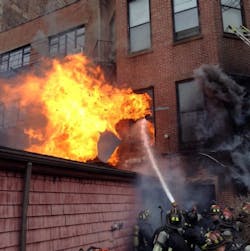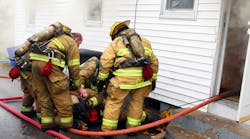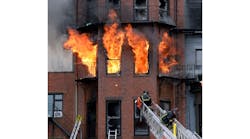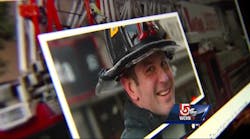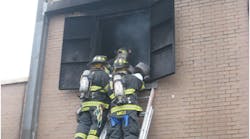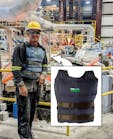NIOSH Report Released on Fire That Killed Two Boston Firefighters
Source Firehouse.com News
The National Institute for Occupational Safety and Health (NIOSH) released a 75-page report on the March 2014 fire that claimed two Boston firefighters.
Lt. Edward Walsh and firefighter Michael Kennedy died after responding to a March 26 fire in a four-story brownstone building. The report listed Walsh's cause of death as smoke inhalation and thermal injuries and Walsh succumbed to smoke inhalation, thermal injuries and blunt force trauma.
“This was the perfect storm, the perfect storm,” Boston Fire Commissioner Joseph E. Finn said Tuesday morning. “A fire burning undetected for a long period of time, sustained winds of 40 mph, gusts up to 70 mph, a building with all of these hidden voids, no fire stopping, the unpermitted welding.
The commissioner cited that funding cuts during the previous mayor's administration accounted for inadequate training, according to the Boston Herald.
“We are doing all this back to basics training," Finn said during the emotional press conference. "We should have been doing that all along. We used to be doing that back 10 years ago, then it just dropped off. Look at the infrastructure of the department, look at this building we are in. Firehouses are crumbling. We have apparatus that is older than the firefighters we are hiring."
Report findings
According to Report 2014-09, factors that contributed tragedy include:
- Delayed notification to the fire department
- Uncontrolled ventilation by a civilian
- Occupied residential building with immediate life safety concerns
- Staffing
- Scene size-up
- Lack of fire hydrants on Side Charlie
- Lack of training regarding wind-driven fires
- Unrestricted flow path of the fire
- Lack of fire sprinkler system
Timeline
Firefighters were dispatched to the building on Beacon Street in the Back Bay neighborhood at 2:42 p.m.
Walsh and Kennedy arrived first on Engine 33 three minutes later and stretched a 1 3/4-inch attack line to the basement where the fire was reported to be burning.
Within less then a minute at 2:49 p.m. Engine 33 called for water in their attack line, but the report said it had already been charged. Command told companies to exit the first floor and Engine 33 called a mayday.
A minute later, Ladder 26 was in the rear of the building and noticed the rapidly changing conditions. They radioed: “Tell Command, we need a line to the back [of the building – Side Charlie]; We have fire showing on the first floor. There is a shed attached to the basement level in the rear. Have companies come around to the street in the rear. The companies can attack the fire from Side Charlie.”
"Both of us are trapped in the basement towards the front of the building. We got water, but the hoseline is burnt through. You have got to charge our line,” Walsh radioed at 2:52.
“Need a line in the basement, right away; a big line," was Walsh's last transmission at 2:57.
Command ordered all crews out of the building at 3:10 p.m.
The crew from Rescue 2 found Kennedy and removed him from the building at 3:19 and Walsh was recovered at 6:48.
Factors and recommendations
The report includes 15 recommendations that range, including reviews of the department's fireground accountability process, annual competency training and a look at the city's building code policies and enforcement.
It was suggested that the department study recent research by NIST and other organizations on wind-driven fires, flow path findings and more.
"Engine 33 had entered the fire building through the front door and moved the hoseline to the stairwell to go down to the basement. With the rear basement doors and the front doors open, the fire had a flow path from the basement, up the stairs to the first floor and floors above," the report states. "This occurred after the interior rear door or window leading into the hallway in the basement failed."
Investigators found that protective hoods were not worn by all firefighters engaged in firefighting operations. They cited that the lack of hoods did not contribute to the fatalities.
The last page of the report includes a suggested tactical worksheet for mayday incidents.
Among the recommendations, listed in the report:
- Recommendation #1: Fire departments should define fireground strategy and tactics for an occupancy that are based upon the organization’s standard operating procedures. As part of the incident action plan, the incident commander should ensure a detailed scene size-up and risk assessment occurs during initial fireground operations including the deployment of resources to Side Charlie. Scene size-up and risk assessment should occur throughout the incident.
- Recommendation #5: Fire departments should ensure that a tactical worksheet is used by Command during initial fireground operations and maintained throughout the incident.
- Recommendation #12: Fire departments should ensure that all members engaged in emergency operations receive annual proficiency training and evaluation on fireground operations.
- Recommendation #15: Code-setting organizations and municipalities should consider requiring the use of sprinkler systems in residential structures. Especially residential occupancies having high fuel loads, other unique life-safety hazards, and to establish retroactive requirements for the installation of fire sprinkler systems.
- Find the full list of recommendations in the NIOSH Report here.
Researches found that the attack hoseline carried by Walsh and Kennedy suffered thermal degradation and was burned in half. A backup hoseline also suffered extensive damage from the heat.
"During this incident, the 1¾-inch attack hoseline used by Engine 33 was burned through during the initial fire-fighting operations. Engine 33 had stretched the hoseline down the stairs from the first floor to the basement. This placed the hoseline in the flow path of the fire and super-heated gases coming up the stairs," the report states.
Investigators called for a review of fire hose standard practices.
